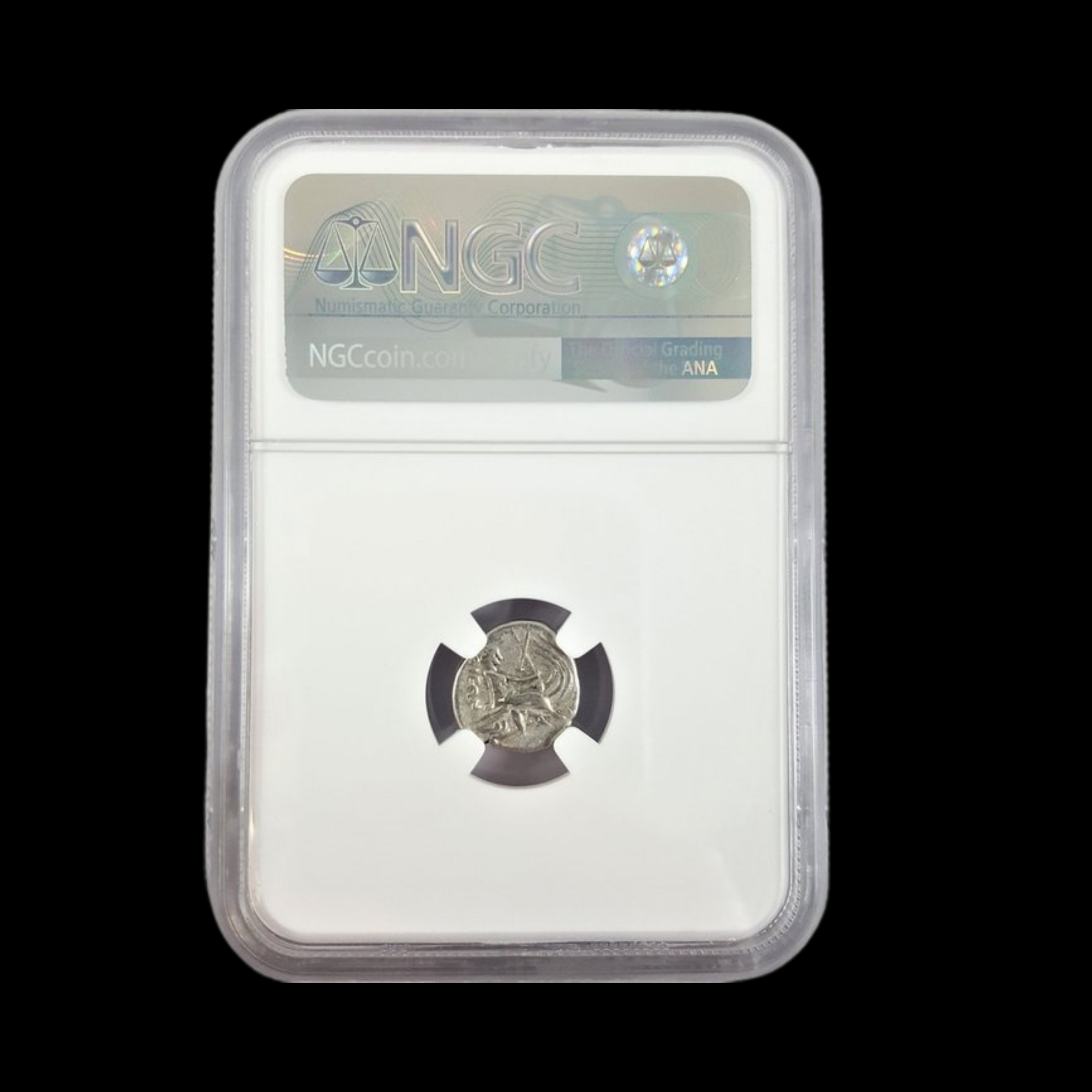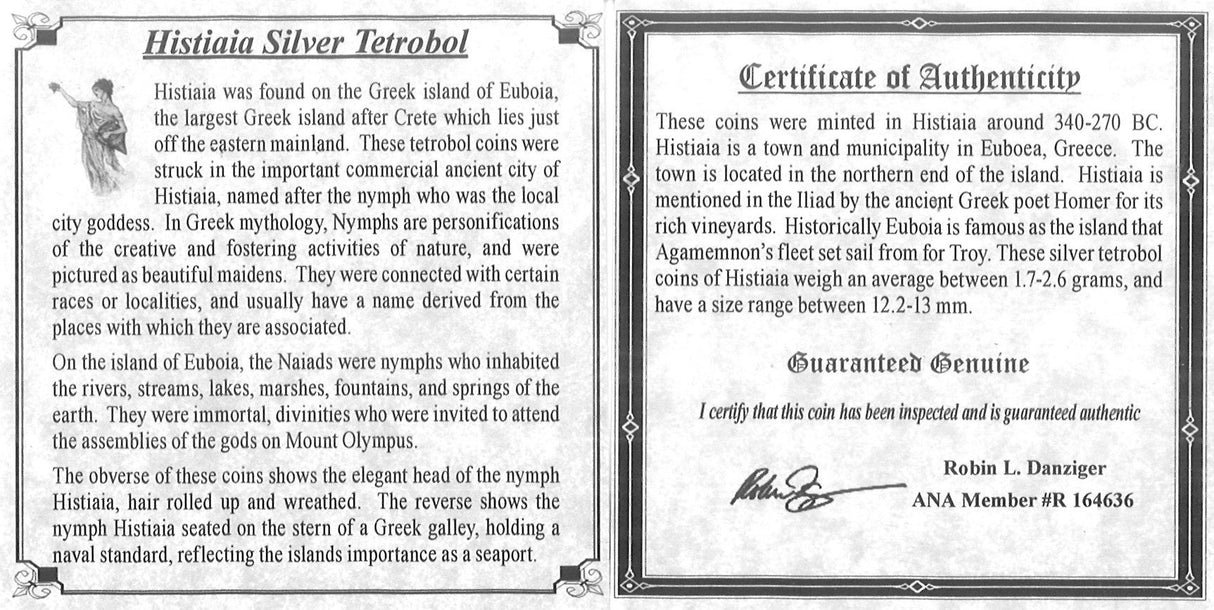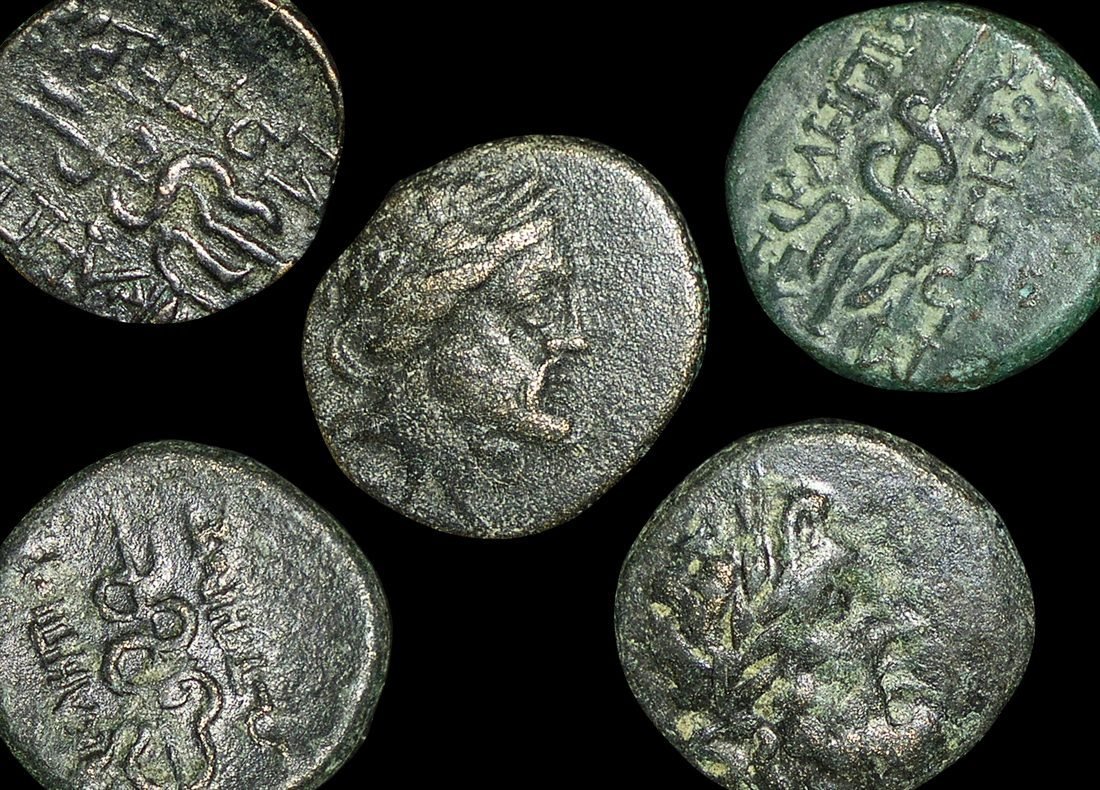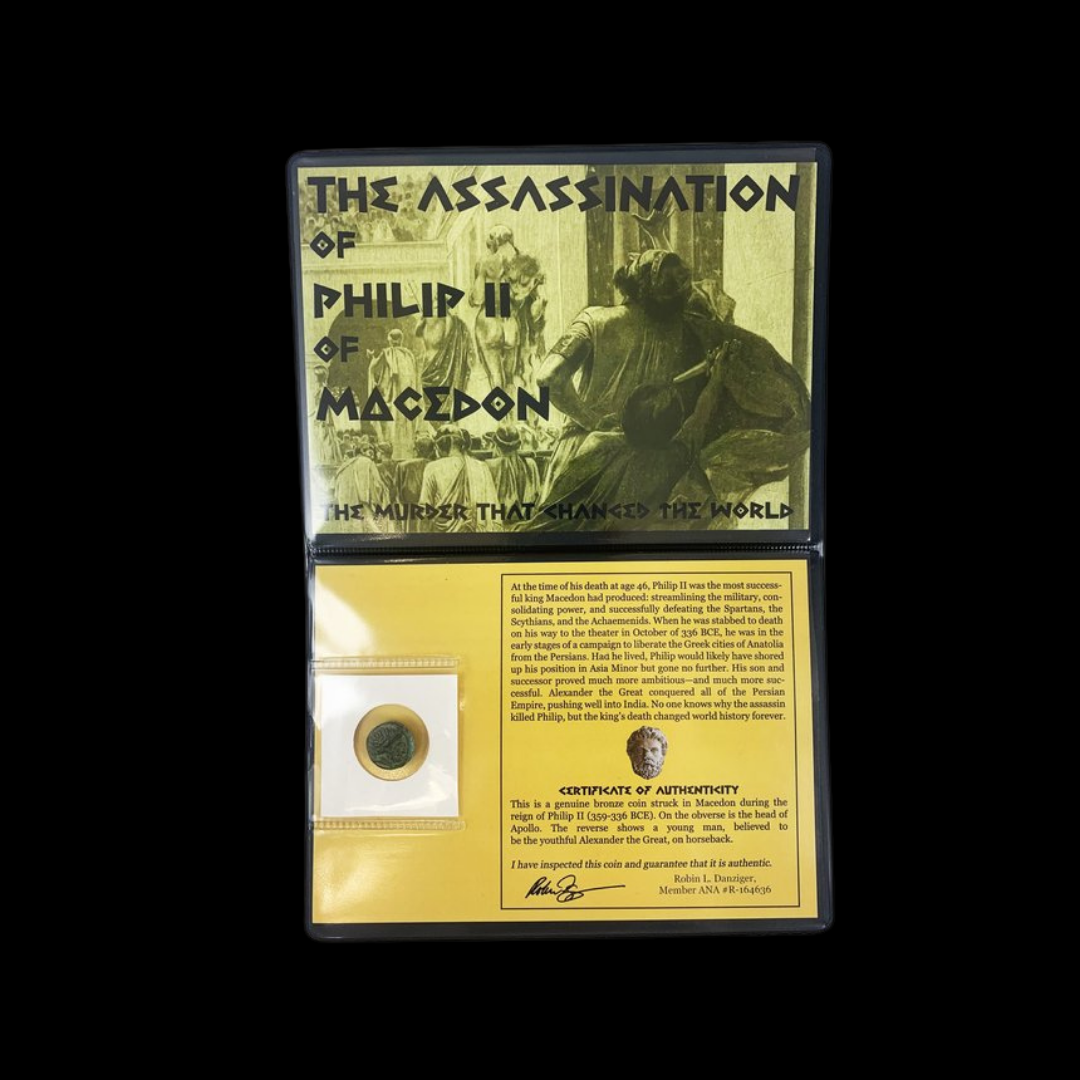 Image 1 of 5
Image 1 of 5

 Image 2 of 5
Image 2 of 5

 Image 3 of 5
Image 3 of 5

 Image 4 of 5
Image 4 of 5

 Image 5 of 5
Image 5 of 5






NGC Tetrobol Of Histaea, Ancient Greece (About 2,300-2,100 years ago) (Hg)
This coin is a tetrobol from the ancient Greek city of Histaea (also spelled Histiaia), located on the island of Euboea (modern Evia in Greece). Minted during the Hellenistic period, this small silver coin was part of the local economy of this important coastal community.
Coin Description:
Front side: Likely depicts the head of a nymph (Histiaea herself) or a deity associated with the city, possibly facing right or left in the Greek style.
Back side: Probably shows a local symbol of Histaea, such as a ship's prow, a vine, or a figure relating to local mythology or economy.
Technical Details:
Silver composition
Tetrobol denomination (equivalent to four obols, or two-thirds of a drachm in the Greek monetary system)
NGC certified with preservation grade (Hg) indicating historical grade
Likely minted between the 4th-2nd centuries BCE
Condition details provided by NGC certification
Historical Significance:
Histaea was an important city on the island of Euboea, named after the mythological nymph Histiaea. As you mentioned in your description, local legend connects the city to Hyrieus, a son of Poseidon, and the story of his stolen treasure. The city was strategically positioned for maritime trade in the Aegean Sea and played a role in regional politics. Histaea minted its own coinage, demonstrating its economic independence and importance in local trade networks. These coins would have circulated throughout ancient Greece and beyond, facilitating commerce in the Mediterranean world during the Classical and Hellenistic periods. The tetrobol was a practical denomination for everyday transactions, representing approximately two-thirds of a day's wage for an average worker in ancient Greece.
This coin is a tetrobol from the ancient Greek city of Histaea (also spelled Histiaia), located on the island of Euboea (modern Evia in Greece). Minted during the Hellenistic period, this small silver coin was part of the local economy of this important coastal community.
Coin Description:
Front side: Likely depicts the head of a nymph (Histiaea herself) or a deity associated with the city, possibly facing right or left in the Greek style.
Back side: Probably shows a local symbol of Histaea, such as a ship's prow, a vine, or a figure relating to local mythology or economy.
Technical Details:
Silver composition
Tetrobol denomination (equivalent to four obols, or two-thirds of a drachm in the Greek monetary system)
NGC certified with preservation grade (Hg) indicating historical grade
Likely minted between the 4th-2nd centuries BCE
Condition details provided by NGC certification
Historical Significance:
Histaea was an important city on the island of Euboea, named after the mythological nymph Histiaea. As you mentioned in your description, local legend connects the city to Hyrieus, a son of Poseidon, and the story of his stolen treasure. The city was strategically positioned for maritime trade in the Aegean Sea and played a role in regional politics. Histaea minted its own coinage, demonstrating its economic independence and importance in local trade networks. These coins would have circulated throughout ancient Greece and beyond, facilitating commerce in the Mediterranean world during the Classical and Hellenistic periods. The tetrobol was a practical denomination for everyday transactions, representing approximately two-thirds of a day's wage for an average worker in ancient Greece.
This coin is a tetrobol from the ancient Greek city of Histaea (also spelled Histiaia), located on the island of Euboea (modern Evia in Greece). Minted during the Hellenistic period, this small silver coin was part of the local economy of this important coastal community.
Coin Description:
Front side: Likely depicts the head of a nymph (Histiaea herself) or a deity associated with the city, possibly facing right or left in the Greek style.
Back side: Probably shows a local symbol of Histaea, such as a ship's prow, a vine, or a figure relating to local mythology or economy.
Technical Details:
Silver composition
Tetrobol denomination (equivalent to four obols, or two-thirds of a drachm in the Greek monetary system)
NGC certified with preservation grade (Hg) indicating historical grade
Likely minted between the 4th-2nd centuries BCE
Condition details provided by NGC certification
Historical Significance:
Histaea was an important city on the island of Euboea, named after the mythological nymph Histiaea. As you mentioned in your description, local legend connects the city to Hyrieus, a son of Poseidon, and the story of his stolen treasure. The city was strategically positioned for maritime trade in the Aegean Sea and played a role in regional politics. Histaea minted its own coinage, demonstrating its economic independence and importance in local trade networks. These coins would have circulated throughout ancient Greece and beyond, facilitating commerce in the Mediterranean world during the Classical and Hellenistic periods. The tetrobol was a practical denomination for everyday transactions, representing approximately two-thirds of a day's wage for an average worker in ancient Greece.
IΣTI / AIEΩN
Oreus or Oreos (Ancient Greek: Ὠρεός, romanized: Ōreos), prior to the 5th century BC called Histiaea or Histiaia (Ἱστίαια), also Hestiaea or Hestiaia (Ἑστίαια), was a town near the north coast of ancient Euboea, situated upon the river Callas, at the foot of Mount Telethrium, and opposite Antron on the Thessalian coast. From this town the whole northern extremity of Euboea was named Histiaeotis (Ἱστιαιῶτις, Ionic Greek: Ἱστιαιῆτις[1]) According to some it was a colony from the Attic deme of Histiaea;[2] according to others it was founded by the Thessalian Perrhaebi.[3] Another foundation story had it that the name Histiaea is said to derive from the mythical figure Histiaea, the daughter of Hyrieus.[4][5] It was one of the most ancient of the Euboean cities. It occurs in the Catalogue of Ships in the Iliad, where Homer gives it the epithet of πολυστάφυλος (rich in grapes);[6] and the Periplus of Pseudo-Scylax mentions it as one of the four cities of Euboea.[7] It was an important city in classical antiquity due to its strategic location at the entrance of the North Euboean Gulf, in the middle of a large and fertile plain.[8]
After the Battle of Artemisium (480 BC), when the Grecian fleet sailed southwards, Histiaea was occupied by the Persians.[1] Upon the expulsion of the Persians from Greece, Histiaea, with the other Euboean towns, became subject to Attica. In the revolt of Euboea from Athens in 446 BC, we may conclude that Histiaea took a prominent part, since Pericles, upon the reduction of the island, expelled the inhabitants from the city, and peopled it with 2000 Athenian colonists. The expelled Histiaeans were said by Theopompus to have withdrawn to Macedonia, or by Strabo to Thessaly thence they transferred the name Histiaeotis.[9][10][11][12] From this time we find the name of the town changed to Oreus, which was originally a deme dependent upon Histiaea.[13] It is true that Thucydides upon one occasion subsequently calls the town by its ancient name;[14] but he speaks of it as Oreus, in relating the second revolt of Euboea in 411 BC, where he says that it was the only town in the island that remained faithful to Athens.[15] Its territory was called Oria (Ὡρία).[16]
You Might Also Like










